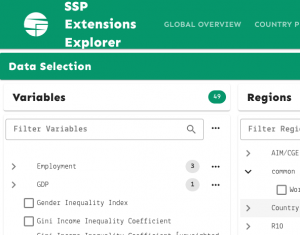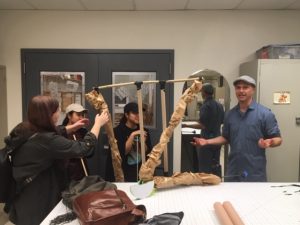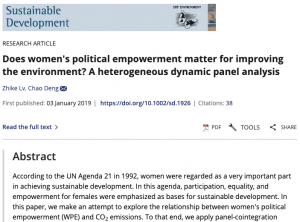In 2022, a team organized by ModLab Project Director Harlin/Hayley Steele and helmed by community partner Osprey Orielle Lake, who is Executive Director of Women’s Earth and Climate Action Network (WECAN) International, offered a presentation at Scenarios Forum, a leading gathering of the stochastic climate modeling community. In this presentation, the team advocated for the inclusion of new metrics in climate models to reflect research that shows improved gender equity has a measurable impact upon emissions. Essentially, when gender equity goes up, emissions go down.
The team’s research included review and analysis of data and findings, developing modeling recommendations for prototypes, strategizing cross-disciplinary communication, and public scholarship. As a community partner, WECAN played a guiding role in reviewing and analyzing data, as well as shaping the team’s communications strategy.
The team’s presentation was featured as part of a panel at Scenarios Forum 2022, where they spoke alongside other researchers from global institutions exploring the possibility of including the impact of “gender inequality” in future climate models. The ModLab team brought data to the table that wasn’t being reviewed elsewhere, and made the case to include gender inequity as an emissions driver in the models.
On February 29th, 2024, a new prototype was released of the next generation of the SSPs, a leading stochastic modeling paradigm used by the UN and leaders around the world to make decisions regarding climate. This prototype, which is called the SSP Extensions Explorer, was shaped by recommendations offered at Scenarios Forum in 2022. In it, metrics can be found that treat gender inequity is a driver of CO2 emissions. This prototype is in process to be incorporated into the SSPs, amending the way this leading modeling paradigm is configured.

Based upon the Scenarios Forum 2022 Meeting Report, we can see that the ModLab team’s panel had an impact on the shape of this new prototype. This panel encouraged the modeling community to investigate the impact of gender equity upon CO2 emissions further, and the modeling community weighed this recommendation and ultimately chose to do so. This later resulted in the inclusion of new “gender inequality” metrics in this latest update-in-progress to the modeling paradigm.
A recorded version of the team’s Scenarios Forum 2022 presentation can be viewed here:
As Steele explains in a statement: “Ultimately, stochastic climate models don’t just tell a story about the future, but they tell a story about how to act in the present. When things are missing from the models, they get left out of strategy discussions.”
Joining Steele and Lake, this team included ModLab Undergraduate Researcher Alisha Chan, WECAN Communications Director Katherine Quaid, and ModLab affiliate Dawn Dietrich, who teaches Cultural Studies and English at Western Washington University.

Steele emphasizes that while the team’s work included novel engagement with stochastic climate modeling regimes, they were drawing upon the data and findings of other researchers to make their case and structure their recommendations.
“Doing this kind of research is more of a relay race than a marathon. Sometimes the people who do the research on what causes emissions don’t quite have the right skills to get their data into the models. That’s why this type of intermediary research is needed. Our team had a good sense of the needs of the modeling community, which allowed us to approach them with the data we reviewed that hadn’t been included and offer a vision for how to fit it into the models.”
When asked where the idea to do this work came from, Steele jokes that it all started with a “laboratory accident.”

From making games about climate to modding climate models
“There was never any sort of plan to do this kind of research.” Steele explains. “It all just accidentally grew out of some game-based projects I was leading at ModLab in the late 2010s.”
Beginning in 2019, Steele began directing a series of ModLab projects that included the development of interactive media pieces that dramatize climate data. Among these projects were Destination Wedding 2070 and Sivad, media pieces structured in such a way that parts of their interactive stories were triggered by things found in climate models.

These media pieces were part of a larger research project Steele directed at ModLab that centered “learning through gamemaking.” As part of this work, Steele led several research groups and a First-Year Seminar in which undergraduate researchers hacked, modded, and designed games that interpreted concepts from technoscience and STS. Steele’s paper articulating “learning through gamemaking” was published in a conference proceedings document in 2023.

“The process of creating these interactive pieces led me and others on the research teams to become quite intimate with certain sets of data and models,” Steele explains. “As it turns out, we became so familiar with them that we were ultimately able to join these modeling communities and offer ideas for how to improve the models—and they listened!”
This work was conducted under the supervision of ModLab Researcher Colin Milburn, who has written on how games come to influence larger society, and was also guided by prior ModLab research conducted by Jospeh Dumit, as described in his article “Game Design as STS research,” and by the influence of ModLab alum Katherine Buse, who has argued that geophysical models are a form of media.
Working with community partners: Bringing in WECAN
Steele emphasizes that bringing in WECAN as a community partner was a key part of developing an impactful presentation for the stochastic climate modeling community.
“We were really just looking at a pile of data, and that can be pretty overwhelming.” Steele explains. “Like, we knew there were things being left out of the models, but where to start?”
Steele first heard about WECAN through the climate activism community. “When I realized they were doing gender and climate,” Steele explains, “I knew I had to reach out.”
Steele explains that WECAN brought focus and a mission to the work. “They led the development of a presentation that went beyond just talking about improving the accuracy of the models, but that also emphasized why a metric like this matters. That made a lot of difference, I think.”
Partnering with community organizations is becoming increasing common among public scholars. Steele received training and gained experience in working with community partners while serving as a UC Davis Humanities Institute Mellon Public Scholar in summer of 2020.
Gender representation in leadership: A key to combatting climate change
Steele emphasizes that the primary reason gender equity impacts emissions is that improves our ability to regulate polluters.
“When better gender representation can be found in decision-making bodies,” Steele explains, “especially as company boards and in higher office, this correlates with the passage of stronger environmental policy.” Steele explains. “That’s where this gender-equity-based emissions reduction comes from.”
When asked how improve gender equity in this way, Steele brings up a study published in Sustainable Development that found when a country had a 1-point increase on the Women’s Political Empowerment Index (W-PEI), that country on average has an 11.51% drop in CO2 emissions over time, even when controlling for other factors.

“And the thing about the W-PEI,” Steele says, “Is it’s not just a measurement of gender representation in leadership. It also looks at other factors, like the presence of women in journalism, the ability of women to travel, to take part in civic society.”
What Steele encourages us to take from this is that it isn’t simply a matter of cramming women onto boards. “This is something that needs to be holistic and systemic,” Steele says. “What these findings shows is that that there needs to be gender equity across every level of society if you want to see this kind of impact.”
When asked if this means women should run everything, Steele refutes the idea. “None of the data we looked at says that,” Steele says. “Rather, there’s a need for balance. There seems to be a psychological component to this. We got into this more in another talk we gave at the gathering. People just make better decisions, it seems, when there’s a good mix of genders and people of different backgrounds in the room.”
Debunking myths about why gender equity reduces emissions (Spoiler Alert: it has nothing to do with birth rates)
Steele has been surprised by the “knee jerk” reactions from people when they first hear that improved gender equity reduces emissions.
“People tend make up reasons for why this is the case,” Steele explains. “Sometimes the reasons they make up are dangerously wrong.”
According to Steele, a common reaction is that people will falsely assume that the reason improved gender equity causes emissions to drop has something to do with birth rates.
“This is demonstrably false.” Steele says. “Overpopulation is a myth—and spreading that myth hurts efforts to regulate polluters.”

Regarding the myth of “overpopulation,” Steele points to the work of ModLab researcher and historian of demography Emily Klancher Merchant. In her award-winning book of history, Building the Population Bomb (Oxford University Press, 2021) Merchant has explored how fossil fuel interests worked in the mid-20th century to manufacture a fail image of scientific consensus regarding the concept of “overpopulation,” which Merchant has called “an accounting trick.” While, as Merchant’s work details, there is no scientific backing to the idea that reducing the number of people on the planet will have any impact upon emissions, the myth of overpopulation persists to this day.
“The myth of overpopulation isn’t just wrong,” Steele explains, “but it causes a ton of problems.” As Steele, explains, a number of social scientists, especially Jade Sasser, have found that the concept of overpopulation sows contention in climate decision-making spaces, which forestalls environmental regulation. “That’s just one way the concept of overpopulation accelerates emissions,” Steele says.
Gender “equality” or “equity”?
Glancing at the new metrics in the models, Steele expresses that they would have preferred that the term “gender equity” had been used in the new prototype rather than “gender equality.” The two terms have different meanings, and “equity” gets closer to the team’s findings, Steele explains.
“But sometimes you can’t get everything you want.” Steele says, “This is still a hopeful advancement. It means the impact of gender equity has a better chance of making it into future climate policy discussions, and that could be a game changer in steering the planet towards the best climate outcome that’s still possible.”
Further research underway
Steele has continued their involvement with the climate scenarios modeling community, and is in the process of organizing further projects that center interventions into leading climate modeling regimes. Steele is also directing a new ModLab project in Spring of 2025 to develop a new modeling paradigm, BasedMIP, which they intend to launch as a new IAM.
Media Coverage:
Common Dreams. “Women’s Group Highlights Gender Equity as a Significant Driver of CO2 Emissions Reduction During Forum on IPCC Climate Modeling” by Katherine Quaid (June 20th, 2022)
UC Davis Climate Blog. “Gender Equity Reduces CO2 Emissions” by Hayley Morris (August 16, 2022)
Suggested citation for the team’s presentation:
Lake, Osprey Orielle, Katherine Quaid, Harlin/Hayley Steele, Alisha Chan, and Dawn Dietrich. “Gender diversity in leadership reduces emissions. What does this mean for our models, and for climate communications in general?” Presented at Scenarios Forum 2022. IIASA Headquarters, Laxemburg, Austria. 20-22 June 2022. Recording at: youtu.be/EiYUWRlhpic

